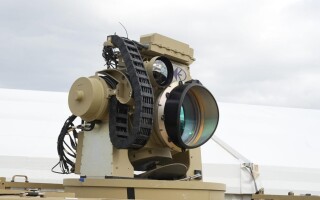Avionics data bus users demand more reliability and flexibility
StoryMarch 10, 2017
New and old military aircraft platforms are continuing to embrace high-speed networks in their new avionics data bus selections, choosing protocols such as high-speed Ethernet and ARINC 429. Meanwhile, MIL-STD 1553 continues to live on in new designs and sustainment contracts despite its slower speeds.
Reliability and flexibility in design are what military avionics integrators want from a data bus solution, whether it is MIL-STD 1553 or 40 GBit Ethernet. While this is a commercial off-the-shelf (COTS) market, avionics data bus users typically want the flexibility to tweak the COTS offerings for their specific needs from size, ruggedization, and cost perspectives.
“Both legacy and new-design aircraft are adding modern, high-speed networks where the requirements and the cost fit within the customers’ budgets,” says Mark Grovak of Curtiss-Wright Defense Solutions. “For new aircraft, it’s a no-brainer to go to 1 or 10 Gb Ethernet networks as they are laying out the wiring in a new aircraft. For legacy aircraft, the math is harder because of the additional cost of rewiring a legacy aircraft with the wiring that supports faster data rates.”
“Proven reliability is a key factor in the selection of an avionics data bus solution,” says Michael Hegarty of Data Device Corp. (DDC). They also want flexible options when it comes to make or buy, he adds. For example, he says, leveraging “COTS board-level solutions or chip-level solutions that can be used to design custom cards.”
Popular protocols
Flexibility is also important when it comes to protocol support, Hegarty notes, with designers wanting the option to go with MIL-STD 1553, ARINC 429, CANbus, RS232/485, discrete I/O, or the like, as well as network-attached solutions using Ethernet or USB.
“One of the most popular commercial avionics data bus solutions today remains ARINC 429,” says Jon Neal, vice president and general manager, Astronics Ballard Technology. “This is commonly used for new avionics displays and systems that are retrofitted onto military aircraft.”
Hegarty says that ARINC 429 “continues to be used for commercial aircraft, although the use of ARINC 664 Part 7 appears to be increasing in those commercial aircraft applications.”
Fibre Channel still has market share in many military avionics applications that called for faster speeds than 1553, says Jack Staub, president of Critical I/O. Now many of their customers are also moving toward Ethernet solutions, he adds. One of Critical I/O’s Fibre Channel offerings is the FCA2540-XMC family, which has two copper or optical interfaces and offers two independent channels of 8/4/2/1 Gbps Fibre Channel in an XMC form factor with PCI-Express host interface.
For its part, DDC offers the ACE Extreme family of products for flexible avionics I/O solutions: A chip-level solution (Total-ACE Extreme), a board-level solution (ACE Extreme boards are available as PMC, XMC, PCIe, Mini-PCIe, and other form factors), or a box-level solution. All ACE products share a common software platform.
Ethernet, Ethernet, Ethernet
“The use of Ethernet as a data plane within mission systems appears to be increasing,” Hegarty says. “Historically, Ethernet has had two main drawbacks – the lack of ’determinism‘ and the overhead associated with the TCP/IP protocol. Both of these factors limit the real-time performance of Ethernet as compared to FibreChannel. There are some new real-time extensions to Ethernet, but their use in avionics is very limited.”
Grovak says he sees growing demand for Ethernet, as it’s the 1 Gb and 10 Gb Ethernet that are the main new data buses that Curtiss-Wright’s customers are requesting. “As the processing capability on aircraft continue to increase, the need for faster networks to move the resulting information around the aircraft will also increase. We see Ethernet as it increases from 10 GbE to 40 GbE and beyond as the main road map. Legacy applications of 2 Gb FibreChannel on F-35 and F/A-18 will be used for the foreseeable future because of the fiber-optic infrastructure in place.”
MIL-STD 1553 demand still strong
As mentioned above, reliability is the key demand from every avionics data bus customer, and what’s more reliable than 1553?
“There are a number of factors for the continued use of 1553,” Hegarty says, starting with the fact that the vast majority of legacy aircraft are using it for command/status between major functional subsystems. Replacing 1553 with an alternative bus would require replacing every electronics box connected to the buses; many existing systems on the platform “don’t need higher bandwidth so it is not worth the investment to replace 1553 with a different technology. [It is a] bulletproof data bus. Other data buses may be faster, but they do not provide similar robustness in terms of their tolerance to electromagnetic effects.”
For modernization and technology upgrades. 1553 has become indispensable for translating signals. “For technology-insertion and aircraft-upgrade programs, new 1553 interface equipment is vital for translating data bus signals to other protocols and networks [such as ARINC 429, Ethernet, CANbus] in order to extend the life of current aircraft and add functionality, while avoiding costly rewiring to change networks,” Neal says. Astronics Ballard Technology offers the rugged AB3000, an airborne computer optimized for processing data between various avionics data buses (MIL-STD-1553, ARINC 429, etc.) and other links such as Ethernet and RS-232. (Figure 1.)
Figure 1: The AB300 from Astronics Ballard Technology enables processing of data between various avionics data buses.
“Eventually, the transition of command/control to Ethernet data transfer buses will occur, enabled by the incorporation of enabling standards within Ethernet such as Precision Time Protocol version 2 (IEEE 1588-2008), Time Sensitive Networking, and other optimizations,” Grovak explains. “In the meantime, phased migration will occur – as the LRUs are replaced, Ethernet will be available on new hardware alongside 1553, giving platform architects options for changeover at a future point when fewer and fewer legacy LRUs are solely dependent on the existing 1553 cabling infrastructure on a platform.”
Another company finding success with MIL-STD 1553 products is North Atlantic Industries (NAI), which offers the MIL-STD-1553B – Dual Channel/Dual Redundant module that provides dual-channel, dual-redundant MIL-STD-1553B Notice 2 interface channels within multifunction embedded boards.
Immortalizing 1553
Some things are certain in life, such as death, taxes, and – it appears – 1553, as there are initiatives underway to give the venerable standard a touch of immortality and of course more speed.
“An important effort to extend the life of the 1553 cabling infrastructure is underway,” Grovak says. “In 2016, STANAG 7221 was released by NATO and was driven by an international effort over the last five years to standardize a high-speed data bus technology that could operate concurrently on the MIL-STD 1553B data bus without impacting the MIL-STD 1553B signaling and without modification to the existing data bus infrastructure. STANAG 7221 has been successfully validated in both fixed- and rotary-wing platforms.”
Avionics data bus testing
Military and commercial end users also want flexibility in data bus test solutions: “Our military customers are consistently looking for avionics data bus solutions that are secure and reliable for both embedded and test applications,” Neal says. “Typical applications include operational systems, protocol translation, and data bus test, simulation, and troubleshooting.”
“Open architectures and flexibility of functionality of FPGA [field-programmable gate array] FW [firmware] and APIs [application program interfaces], with the APIs common across operating systems and board types; also, real-time support (pre- and post-sale) is a key component of what they are expecting,” says Abaco Systems’ Ben Daniel. “As hosts move to current tech, there is an obvious migration from PCI to PCIe, both in rackmount/desktop hosts and in PMC to XMC migration for embedded applications. In parallel, the host operating systems are constantly updating, so there is a continuous migration to support those. Again in parallel, new designs take advantage of the latest available components, so the capability versus footprint and price benefits the market. There is also an increase in interest around small-form-factor applications, not just in low SWaP [size, weight, and power] systems – VPX and the like – but in nontraditional, very small systems for embedded applications.” Abaco Systems offers the R15-MPCIE two-channel 1553 board with discretes and the RAR-MPCIE 8RX/4TX ARINC 429 board with discretes.






